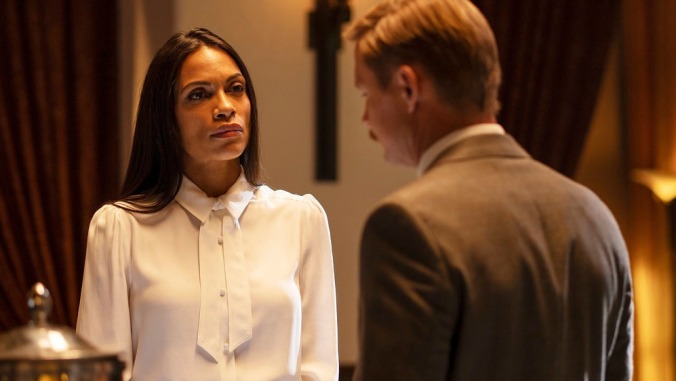That main character is Allegra Dill (Rosario Dawson), a D.C. fixer for an up-and-coming U.S. Senator, and a woman comfortable occupying the gray area between right and wrong to get things done for her bosses. Dill returns to her long-abandoned hometown of St. Boniface, Texas, after her estranged sister Felicity, a local cop, is killed by a car bomb outside the ramshackle apartment building she also owned. Vowing not to leave again until she figures out who killed her sister and why, Allegra quickly meets a parade of idiosyncratic locals, many of whom she knew in her younger days, and nearly all of whom are hiding secrets of some kind. (Briarpatch never met a backstory or character arc it couldn’t twist into something more convoluted than necessary.) There’s the lawyer who drew up the sister’s will not three weeks prior (Edi Gathegi); Felicity’s fellow-cop boyfriend (Brian Geraghty) who happens to be inconveniently married; Floyd (Jon Beavers), Felicity’s no-class tenant that is far too interested in Allegra’s actions; the shady police chief (Kim Dickens); and more, all of whom end up connected in some way or another to the mystery.
The show gets its juiciest drama out of the playfully antagonistic relationship between Allegra and Jake Spivey (Mad Men’s Jay R. Ferguson), a childhood friend who joined the army and ended up making millions in the arms trade under less-than-legitimate circumstances. When Allegra’s boss instructs her to strike an immunity deal with Jake so he’ll testify against an old gun-running partner under Senate investigation, it’s only a matter of time before the overlap between her professional obligations and her personal manhunt for her sister’s killer starts to appear. Ferguson makes Jake a multilayered menace: garrulous buffoon on the outside, tossing around money and margaritas on a lavish estate (he’s very proud of his pet giraffes), with a wily military mind and elite soldier’s training buried just below the surface. The exchanges between Jake and Allegra crackle with chemistry, the two delivering a hot-and-cold dynamic that helps overcome some of the more meandering sprawl of the plot—and the overlong time it takes for the show to start digging into Allegra herself.
The icy distance at which the show holds Allegra in its early going makes it difficult to lock into the material. She’s more a collection of writerly tics than a fully dimensional person (she takes long drags from cigarettes without ever lighting one), so as each new facet of her personality comes to light, there’s no baseline identity on which to affix our understanding. By the time Briarpatch finally invests in her history and motivation, we’re already neck-deep in double crosses and conspiracies involving immigration, local town-hall politicking, and the ongoing murder mystery that slowly consumes everyone and everything. With each new player or fleeting cameo—hi, Peter Stormare as a bowling-alley owner!—the show takes off in too many directions, struggling to do justice to each of these scenes and situations. (Best of the bunch: Alan Cumming guest stars in several episodes as a key player in the machinations, and looks like he’s having more fun camping it up than every other person combined.)
Part of the difficulty is that Briarpatch wants to be a deeper show than it is. There are several moments of eerie, almost supernatural portentousness that slot in awkwardly alongside the affable Southern-fried dramedy. And the show continually tries to drop in quirky symbolism and load meaning onto clunkily staged imagery that comes across more forced than fanciful or effective. It ends up being several shows in one—gumshoe mystery, political intrigue potboiler, and small-town soap. Each one has its pleasures, but sit together uneasily, like the series couldn’t bear to not be all things to all people.
Still, when it calms down and manages to settle in to a single story for sufficient lengths of time, Briarpatch is alive with wit and style. The fourth episode revolves around Felicity’s funeral, and the chance to dig into the consequences of her death on everyone in St. Boniface makes for a sharp installment, complete with a needle drop that would do Quentin Tarantino proud. Similarly, an episode-long invasion of Spivey’s compound that kicks off the show’s back half is gripping stuff, culminating in a reveal of the overarching plot that almost justifies some of the narrative knots into which earlier episodes tied themselves. This series has a lot of promise, but it’s running too hot out of the gate, refusing to sacrifice breadth of ambition for focus. Briarpatch has a wonderful cast and some inspired ideas; if it can slow down and figure out a more elegant way to deliver its fusion of icy cool and ramshackle quirk, St. Boniface will become a wry and appealing place for viewers to put down some roots.


